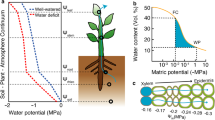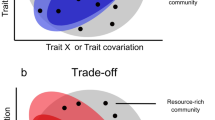Abstract
Simultaneous field measurements of transpiration and sap flow were performed on short-rotation Salix viminalis trees ranging in diameter from 1.5 to 3.5 cm (2-year-old shoots on 8-year-old stumps). Transpiration was measured using an open-top ventilated chamber enclosing the whole foliage of a tree. Sap flow was measured using a tree-trunk heat balance (THB) technique with a constant temperature difference and variable heat input. Both the instantaneous and daily values of water flux measured by the two absolute techniques agreed well with a difference of up to about 5%. In July, the hourly transpiration reached a maximum of about 0.2 kg m−2 (leaf area) or 0.45 kg tree−1, whereas maximum daily integrals reached 4 kg tree−1. The response of sap flow rate to abrupt flux change when inducing emboli by cutting-off the stem was very rapid: the registered signal dropped by 85% within 10 min for a specimen with a projected leaf area of 2 m2. For S. viminalis trees, transpiration was linearly correlated with stem cross-sectional area and with leaf area.
Similar content being viewed by others
References
Baker JM, Van Bavel CHM (1987) Measurements of mass flow of water in the stems of herbaceous plants. Plant Cell Environ 10: 777–782
Čermák J (1992) Transpiration of trees and its importance in forest ecology (in Czech). Assoc Prof Thesis, Agricultural University of Brno, Czech Republic
Čermák J, Kučera J (1991) Extremely fast changes of xylem water flow rate in mature trees, caused by atmospheric, soil and mechanical factors. In: Raschi A, Borghetti M (eds) Proc CEC Int Workshop “Methodologies to assess the impacts of climatic changes on vegetation: analysis pf water transport in plants and cavitation of xylem conduits”, May 29–31, Florence, Italy, pp 181–190
Cermák J, Deml M, Penka M (1973) A new method of sap flow rate determination in trees. Biol Plant (Praha) 15: 171–178
Čermák J, Ulehla J, Kučera J, Penka M (1982) Sap flow rate and transpiration dynamics in the full-grown oak (Quercus robur L.) in floodplain forest exposed to seasonal floods as related to potential evapotranspiration and tree dimensions. Biol Plant (Praha) 24: 446–460
Čermák J, Jenik J, Kučera J, Zidek V (1984) Xylem water flow in a crack willow tree (Salix fragilis L.) in relation to diurnal changes of environment. Oecologia 64: 145–151
Chandra S, Lindsey PA, Bassuk NL (1994) A gauge to measure the mass flow rate of water in trees. Plant Cell Environ 17: 867–874
Cienciala E, Lindroth A (1994) Gas-exchange and sap flow measurements of Salix viminalis trees in short-rotation forest. II. Diurnal and seasonal variations of stomatal response and water use efficiency. Trees 9: 295–301
Cienciala E, Eckersten H, Lindroth A, Hällgren J-E (1994) Simulated and measured water uptake by Picea abies under non-limiting soil water conditions. Agr For Meteorol 71: 147–164
Daum CR (1967) A method for determining water transport in trees. Ecology 48: 425–431
Denmead OT, Dunin FX, Wong SC, Greenwood EAN (1993) Measuring water use efficiency of Eucalyptus trees with chambers and micrometeorological techniques. J Hydrol 150: 649–664
Eckersten H, Lindroth A, Nilsson L-O (1989) Simulated growth of willow stands related to variations in weather and foliage nitrogen content. In: Perttu KL, Kowalik PJ (eds) Modelling of energy forestry: growth, water relations and economics. Pudoc, Wageningen, pp 33–64
Grip H, Halldin S, Lindroth A (1989) Water use by intensively cultivated willow using estimated stomatal parameters values. Hydrol Processes 3: 51–63
Kučera J, Čermák J, Penka M (1977) Improved thermal method of continual recording of transpiration flow rate dynamics. Biol Plant (Praha) 19: 413–420
Lindroth A, Iritz Z (1993) Surface energy budget dynamics of shortrotation willow forest. Theor Appl Climatol 47: 175–185
Lindroth A, Čermák J, Kučera J, Cienciala E, Eckersten H (1995) Sap flow by heat balance method applied to small size Salix trees in a short rotation forest. Biomass Bioenergy (in press)
Olsson MT, Samils B (1984) Site characterisation at energy forest production. Swedish University of Agricultural Science Report on Forest Ecology and Forest Soils, vol. 48. Uppsala, Sweden
Pallardy SG, Pereira JS, Parker WC (1991) Measuring the state of water in tree systems. In: Lassoie JP, Hinckley TM (eds) Techniques and approaches in forest tree ecophysiology, CRC Press, Boca Raton, Florida, pp 27–76
Perrier A (1979) Physical model to simulate energy exchange of plant canopies. In: Halldin S (ed) Comparison of forest water and energy exchange models. Proceedings from an IUFRO workshop, Uppsala, 24–30 September 1978. Int Soc Ecol Modelling, Copenhagen, pp 101–113
Persson G, Lindroth A (1994) Simulating evaporation from shortrotation forest. Variations within and between seasons. J Hydrol 156: 21–45
Rytter L, Ericsson T (1993) Leaf nutrient analysis in Salix viminalis (L.) energy forest stands growing on agricultural land. Z Pflanzenernähr Bodenk 156: 349–356
Rychnovska M, Čermák J, Smid P (1980) Water output in a stand of Phragmites communis Trin. A comparison of three methods. Acta Sci Nat (Brno) 14: 1–27
Sakuratani T (1981) A heat balance method for measuring water flux in the stem of intact plants. J Agric Meteorol 34: 177–187
Schulze E-D, Čermák J, Matyssek R, Penka M, Zimmermann R, Vasicek F, Gries W, Kučera J (1985) Canopy transpiration and water fluxes in the xylem of the trunk of Larix and Picea trees — a comparison of xylem flow, porometer and cuvette measurements. Oecologia 66: 475–483
Steinberg S, Van Bavel CHM, McFarland MJ (1989) A gauge to measure mass flow rate of sap in stems and trunks of woody plants. J Am Soc Hort Sci 114: 466–472
Valinger E (1993) Crown development of Scots pine trees following thinning and nitrogen fertilization. Stud For Suec 188: 1–12
Verwijst T (1991) Shoot mortality and dynamics of live and dead biomass in stand of Salix viminalis. Biomass Bioenergy 1: 33–39
Author information
Authors and Affiliations
Rights and permissions
About this article
Cite this article
Cienciala, E., Lindroth, A. Gas-exchange and sap flow measurements of Salix viminalis trees in short-rotation forest. Trees 9, 289–294 (1995). https://doi.org/10.1007/BF00202019
Received:
Accepted:
Issue Date:
DOI: https://doi.org/10.1007/BF00202019




